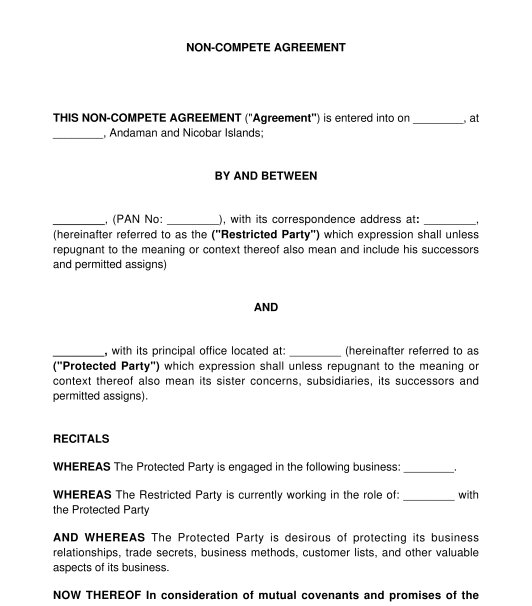 14-09-2025
14-09-2025

Answer a few questions and your document is created automatically.

Your document is ready! You will receive it in Word and PDF formats. You will be able to modify it.

 14-09-2025
14-09-2025
 Word and PDF
Word and PDF
 5 to 7 pages
5 to 7 pages
The Non-Compete Agreement is a legal document under which the one party ("Restricted Party") agrees to not enter into the competition of any kind during and for such duration after the termination of the business relationship with the other party ("Protected Party"). Non-Compete Agreement can be used by a business to retain valuable employees, protect its confidential information and customers, and prevent unfair competition.
The Non-Compete Agreement ensures that the Restricted Party will not use the information or skills learned during the term of the business relationship to start a business and compete with the Protected Party in the Relevant Market (where the Protected Party does business or such geographical area specified under this Agreement), during or once the business relationship is over.
The Non-Compete Agreements are generally divided into the following two categories:
A Non-Compete Agreement specifically restricts competition or starting a similar business for a particular period in a particular location. On the other hand, a Non-Disclosure Agreement focuses solely on preventing the disclosure of confidential information or secret information of the party disclosing it to the other party.
No, it is not mandatory. However, having written a Non-Compete Agreement will help in protecting the business interest and prevent unfair competition.
Any individual above the age of 18 years or entities registered in India can enter into a Non-Compete Agreement.
The duration of a Non-Compete Agreement can vary, typically ranging from 6 months to 2 years. It depends on the nature of the business, industry standards and the role of the concerned employee.
The Non-Compete Agreement would need to be printed on non-judicial stamp paper or e-stamp paper, which is available in certain states. The value of the stamp paper would depend on the state in which it is executed. Each state in India has provisions in respect of the amount of stamp duty payable on the Non-Compete Agreement. Information regarding the stamp duty payable can be found on the State government websites.
After printing the document on stamp paper or e-stamp paper, as applicable, both parties should sign the lease deed and each party should keep a copy of the Non-Compete Agreement.
A Non-Compete Agreement must include the following clauses:
In India, Non-Compete Agreements are generally barred under Section 27 of Indian Contract Act, 1872. But the Supreme Court of India in the recent judgements has specified that certain types of Non-Compete Agreements can be enforced to protect the genuine interests of the Companies. A Non-Compete Agreement will be enforceable under the Indian Contract Act, 1872.
The duration and geographical area of duration must be reasonable and protect the interest of the party to be enforceable under the law.
You fill out a form. The document is created before your eyes as you respond to the questions.
At the end, you receive it in Word and PDF formats. You can modify it and reuse it.
Guides to help you
Non-Compete Agreement - Sample, template - Word and PDF
Country: India